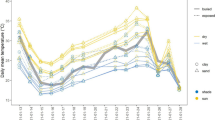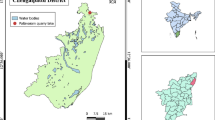Abstract
The toxic concentration for un-ionized ammonia (NH3) was assessed for nine native New Zealand invertebrate species. The 96-h EC50 values at 15°C and pH 7.6 and pH 8.2 ranged from 0.18 to >0.8 g/m3 NH3. The rank of species sensitivity was: shrimp (Paratya curvirostris) (least) ≈ mayfly (Zephlebia dentata) ≈ stonefly (Zealandobius furcillatus) < Oligochaeta (Lumbriculus variegatus) < fingernail clam (Sphaerium novaezelandiae) < mayfly (Deleatidium spp.) < a snail (Potamopyrgus antipodarum) < caddis (Pycnocentria evecta) < crustacean (Paracalliope fluviatilis) (most). Surprisingly, the more sensitive species were those which would normally be associated with lowland streams (the snail and crustacean) rather than the normally accepted “sensitive” species (mayflies and stoneflies). Temperature had no significant effect on the acute toxicity of un-ionized ammonia with snails tested at 15, 20, and 25°C. The invertebrates were more sensitive than the native fish species tested (inanga, EC50 1.60 g/m3 NH3; Richardson 1991). A final acute value (FAV) calculated for these species was 0.15 g/m3 NH3. This compares with the FAV value of 0.52 g/m3 NH3 derived by the US Environmental Protection Agency (EPA) as the basis for the ammonia criterion for salmonid containing waters. Thus EPA criteria may not provide adequate protection for New Zealand species. These data suggest that chronic studies would be particularly desirable on native New Zealand species to better determine their sensitivity to long term ammonia exposure.
Similar content being viewed by others
References
American Public Health Association, American Water Works Association, Water Pollution Control Federation (1989) Standard Methods for the examination of water and wastewater (17th edition). Am Publ Health Assoc, Washington DC
Arthur JW, West CW, Allen KN, Hedtke SF (1987) Seasonal toxicity of ammonia to five fish and nine invertebrate species. Bull Environ Contam Toxicol 38:324–331
Cooper AB (1984) Activities of benthic nitrifiers in streams and their role in oxygen consumption. Microbial Ecol 10:317–334
— (1986) Developing management guidelines for river nitrogenous oxygen demand. J WPCF 58:845–852
Diamond JM, Mackler DG, Rasnake WJ, Gruber D (1993) Derivation of site-specific ammonia criteria for an effluent-dominated headwater stream. Environ Toxicol Chem 12:649–658
Emerson K, Russo RC, Lund RE, Thurston RV (1975) Aqueous ammonia equilibrium calculations: effect of pH and temperature. J Fish Res Board Can 32:2379–2383
Erickson RJ (1985) An evaluation of mathematical models for the effects of pH and temperature on ammonia toxicity to aquatic organisms. Water Res 19:1047–1058
Finney DJ (1971) Probit Analysis. Cambridge University Press, Cambridge
Gersich FM, Hopkins DL (1986) Site-specific acute and chronic toxicity of ammonia to Daphnia magna Straus. Environ Toxicol Chem 5:443–447
Hermanutz RO, Hedtke SF, Arthur JW, Andrew RW, Allen KN, Helgen JC (1987) Ammonia effects on microinvertebrates and fish in outdoor experimented streams. Environ Pollut 47:249–283
Hickey CW, Quinn JM, Davies-Colley RJ (1989) Effluent characteristics of dairy-shed oxidation ponds and their potential impacts on rivers. NZ J Mar Freshwat Res 23:569–584
Hickey CW, Quinn JM, Vant WN, McBride GB (1990) Water quality and residual flow studies: Ararimu (Campbell Road) scheme. Part 1 (a progress report). Auckland Regional Council Operations Division (Bulk Water), Auckland, New Zealand
Hickey CW, Rutherford JC (1986) Agricultural point-source discharges and their effects on rivers. NZ Ag Sci 20:104–109
Hickey CW, Vickers ML (1992) Comparison of the sensitivity to heavy metals and pentachlorophenol of the mayflies Deleatidium spp. and the cladoceran Daphnia magna. NZ J Mar Freshwat Res 26:87–93
Kuiper JGJ (1966) Critical revision of the Sphaeriid clams in the Dominium Museum, Wellington. Records Dominium Museum 5:147–162
Quinn JM, Hickey CW (1990) Characterisation and classification of benthic invertebrate communities in 88 New Zealand rivers in relation to environmental factors. NZ J Mar Freshwat Res 24:387–409
Richardson J (1991) Acute toxicity of ammonia to juvenile inanga (Galaxus maculatus). NZ J Mar Freshwat Res 25:327–330
SAS (1985) SAS user's guide (version 5 ed). SAS Institute, Cary, NC
Stephan CE, Mount DI, Hansen DJ, Gentile JH, Chapman GA, Brungs WA (1985) Guidelines for deriving numerical national water quality criteria for the protection of aquatic organisms and their uses (NTIS PB85–227049). US Environmental Protection Agency, Office of Research and Development, Washington, DC
U.S. Environmental Protection Agency (1983) Guidelines for deriving site-specific water quality criteria. In: Water quality standards handbook. USEPA Office of Water Regulations and Standards, Washington, DC, pp 4.1-4.20
U.S. Environmental Protection Agency (1985) Ambient water quality criteria for ammonia—1984. USEPA Criteria and Standard Division, Washington, DC
Williams K, Green D, Pascoe D (1984) Toxicity testing with freshwater macroinvertebrates: Methods and application in environmental management. In: Pascoe D, Edwards RW (eds), Freshwater biological monitoring. Pergamon, Oxford, pp 81–91
Winterbourn MJ (1969) Water temperature as a factor limiting the distribution of Potamopyrgus antipodarum (Gastropoda-Prosobranchia) in the New Zealand thermal region. NZ J Mar Freshwat Res 3:453–458
Winterbourn MJ (1973) A guide to the freshwater Mollusca of New Zealand. Tuatara 20:141–159
Zischke JA, Arthur JW (1987) Effects of elevated ammonia levels on the fingernail clam, Musculium transversum, in outdoor experimental streams. Arch Environ Contam Toxicol 16:225–231
Author information
Authors and Affiliations
Rights and permissions
About this article
Cite this article
Hickey, C.W., Vickers, M.L. Toxicity of ammonia to nine native New Zealand freshwater invertebrate species. Arch. Environ. Contam. Toxicol. 26, 292–298 (1994). https://doi.org/10.1007/BF00203554
Received:
Revised:
Issue Date:
DOI: https://doi.org/10.1007/BF00203554




